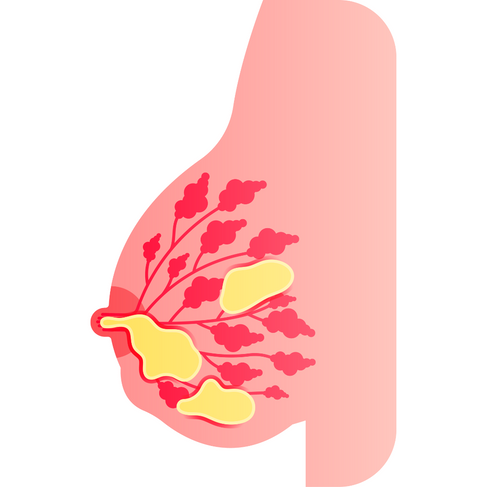Clogged Ducts vs. Mastitis
- Carly Gossard

- Jul 15
- 3 min read
So there you are, mid-feed, when you feel it: a hard, sore lump in your boob. Is it a clogged duct? Is it mastitis? Before you Google yourself into a spiral, let me help you break it down, one boob at a time.
Clogged Ducts: The Traffic Jam of the Breastfeeding World
Clogged ducts are like that one car that parks sideways and blocks an entire lane. Milk isn’t flowing smoothly, and the backup causes swelling and discomfort.
Signs it’s a clogged duct:
A firm, tender lump (feels like a small marble or pea)
The area may look a little red, but not flaming hot
You don’t have a fever or chills (yet)
It hurts most when baby latches (but also kind of feels better after)
Why it happens:
Skipped or rushed feedings
Tight bras
Poor latch or shallow suck
Overproduction or inefficient milk removal
Treat it like a pro:
Frequent feeding or pumping (start on the affected side)
Warm compresses before feeding, gentle massage during
Dangle feeding (yes, you look ridiculous but gravity helps)
Lecithin supplements may help prevent future clogs
Bonus tip: If you’re also slouching over your baby 12 times a day, your poor posture could be messing with milk flow and your pelvic floor. Time for a little posture pep talk and maybe a PT visit.
Mastitis: When Your Boob is Angry AND Inflamed
If a clogged duct is a traffic jam, mastitis is the road rage that follows when no one clears it up.
Signs of mastitis:
Swollen, red, hot area on the breast (sometimes wedge-shaped)
Fever over 100.4°F (38°C) and chills
Body aches, fatigue, maybe even feeling flu-ish
Pain that goes from “uncomfortable” to “GET OFF ME, BABY”
What’s happening: Milk gets stuck, bacteria sneak in through a cracked nipple, inflammation or infection sets up shop.
What to do next:
Keep feeding or pumping (seriously, don’t stop)
Rest like your recovery depends on it - because it does
Ibuprofen for inflammation and pain
Call your provider - if symptoms last over 24 hours or worsen, you might need antibiotics
Pelvic Floor Bonus Round: Yes, It’s Connected
While we’re here can we talk about how tension and posture can actually affect your boobs?
If your shoulders are hunched, your ribs compressed, and your abs disengaged, lymphatic drainage can slow down, making clogged ducts more likely. (See? Your pelvic floor therapist isn’t just worried about pee leaks, they’re out here saving your boobs too.)
So, Is It a Clog or Mastitis?
Symptom | Clogged Duct | Mastitis |
Lump | Yes | Yes |
Redness | Maybe | Usually (hot/red area) |
Fever | No | Yes |
Flu-like symptoms | No | Yes |
Feels better after nursing | Yes | Sometimes |
Final Thoughts
Your boobs work hard. They’re on the clock 24/7, dealing with demand, supply, and occasional feeding difficulties with a tiny, adorable human. Don’t ignore the signs. If something feels off, don’t wait. Catch a clog early, and you’ll avoid mastitis. Catch mastitis early, and it’s very well managed and treated.
And if you’re leaking when you sneeze, your back is killing you during feeds, or you’re clenching your jaw - call your pelvic floor therapist too. You deserve comfort everywhere, not just at the boob level.
Got questions? Whether your milk is misbehaving or your pelvic floor is throwing shade, we’ve got your back (and front). Let’s get you feeling strong, supported, and fully unclogged.
References:
Yao, Y., et al. “A Five‑step Systematic Therapy for Treating Plugged Ducts and Mastitis in Breastfeeding Women: A Case‑Control Study.” Asian Nursing Research, vol. 15, no. 3, 2021, pp. 197–202. PubMed. – Demonstrates effective pain and swelling reduction in both plugged ducts and mastitis using a standardized therapy protocol. PMC+15PubMed+15Parents+15
Munsittikul, N., et al. “Integrated Breast Massage versus Traditional Breast Massage for Treatment of Plugged Milk Duct in Lactating Women: A Randomized Controlled Trial.” International Breastfeeding Journal, vol. 17, no. 43, 2022. – Shows improved resolution of duct blockages through targeted massage techniques. Wikipedia+3BioMed Central+3PMC+3
Lavigne, V., & Gleberzon, B. J. “Ultrasound as a Treatment of Mammary Blocked Duct Among 25 Postpartum Lactating Women: A Retrospective Case Series.” Journal of Chiropractic Medicine, vol. 11, no. 3, Sept. 2012, pp. 170–178. – Reports positive outcomes using ultrasound therapy for recurrent blocked ducts.
Anderson, C., et al. “A Descriptive Study of Lactation Mastitis in Long-Term Breastfeeding Women.” PubMed, no. 2346600, Feb. 1990. – Highlights mastitis prevalence, flu-like symptoms, and its frequent link to previous duct blockages. Verywell Family+13PubMed+13PMC+13PMC+4Parents+4PMC+4
World Health Organization et al. “Mastitis While Breastfeeding: Prevention, the Importance of Proper Treatment, and Potential Complications.” PMCID 7465810, 2020. – Defines clinical progression: from milk stasis → inflammation → infection; outlines diagnosis/treatment guidelines. PMC+3PMC+3Wikipedia+3
Wilson, C., et al. “Incidence of and Risk Factors for Lactational Mastitis: A Systematic Review.” PMCID 7672676, 2021. – Notes mastitis affects roughly 25% of breastfeeding women, with blocked ducts as a key risk factor.











Comments